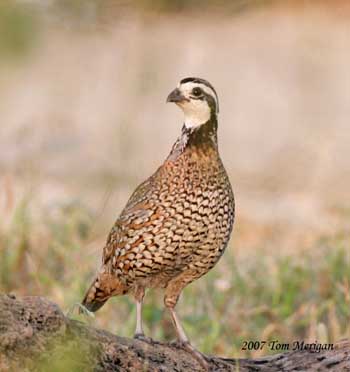
Fr: Colin de Virginie
All : Virginiawachtel
Esp : Colín de Virginia
Ital: Colino della Virginia
Nd: Boomkwartel
Sd: Vitstrupig vaktel
Photographers:
Tom Grey
Tom Grey's Bird Pictures
Tom Merigan
Tom Merigan’s Photo Galleries
Texte de Nicole Bouglouan
Sources:
HANDBOOK OF THE BIRDS OF THE WORLD Vol 2 by Josep del Hoyo-Andrew Elliot-Jordi Sargatal - Lynx Edicions - ISBN: 8487334156
A GUIDE TO THE BIRDS OF MEXICO AND NORTHERN CENTRAL AMERICA by Steve N. G. Howell, Sophie Webb - Oxford University Press - ISBN: 0198540124
FIELD GUIDE TO THE BIRDS OF NORTH AMERICA - National Geographic Society - ISBN: 0792274512
All About Birds (Cornell Lab of Ornithology)
BirdLife International (BirdLife International)
What Bird-The ultimate Bird Guide (Mitchell Waite)
Wikipedia, the free encyclopaedia
Northern Bobwhite
Colinus virginianus
Galliforme Order – Odontophoridae Family
BIOMETRICS:
Length: 20-25 cm
Weight: it increases from south to north, from 129 g to 173 g
DESCRIPTION:
The Northern Bobwhite is a ground-dwelling plump quail. Formerly placed in the Family Phasianidae with the Old World quails, this species is now closely related to Odontophoridae, with the typical North American quails, although it lacks the conspicuous crest.

The adult male body plumage shows great variation on head and upperparts. The plumage is a combination of grey, brown and white. The upperparts are mostly greyish-brown, and the underparts are chestnut-brown with white spots bordered with black. The tail is grey.
On the head, we can see a white supercilium from forehead to hind neck. The crown is greyish-brown. A blackish eyeline extends to ear-coverts and down to the foreneck, and forms a black collar. Chin, throat and malar area are white.
The bill is blackish. The eyes are dark brown. Legs and feet are horn-coloured.
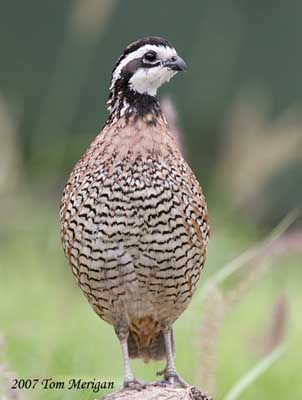
The female has similar pattern but less contrasted on the head with buffy-white and paler brown areas.
The juvenile is duller than adults.
There are numerous subspecies which differ on plumage and size.
VOICE: SOUNDS BY XENO-CANTO
The Northern Bobwhite has a repertoire of 19 distinct calls, and mainly a whistle-like “bob-WHITE” or “bob-bob-WHITE” giving the bird its English name.
Each note is slow and widely spaced from others. This call rises in pitch from the beginning to the end.
We can also hear lisps, peeps and the alarm call is a series of rapid, whistled warning calls “hwuik-hwuik-hwuik”.
HABITAT:
The Northern Bobwhite frequents various habitats according to each population. They usually frequent pine woodlands and edges, shrubs, cultivated areas and pastures, and fallow fields.
RANGE:
The Northern Bobwhite is native to the United States, Mexico and the Caribbean. This species has been introduced into several places such as British Columbia, Puerto Rico, Hawaii, New Zealand and West Indies, and also in NW USA.
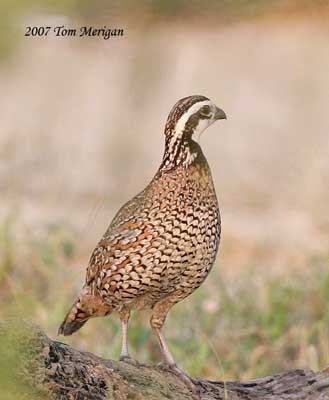
BEHAVIOUR:
The Northern Bobwhite feeds primarily on seeds of several plant species, and also oak acorns, cultivated corn and wheat, and tomatoes.
According to the range, it also takes legume seeds, and in agricultural regions, its diet varies with the crops. During summer, it consumes a lot of insects.

The Northern Bobwhite is a shy bird, preferring to hide in the vegetation when disturbed or threatened. It can remain motionless, and its plumage blends into the environment.
These birds are gregarious and live in groups or “coveys” outside the breeding season. At the beginning of this period, the coveys disperse and the pairs prepare the nesting period.
The courtship displays involve several lateral and frontal postures by the male, in order to expose the plumage and head pattern towards the female, white the wings are dropped or spread.
They also perform ritual courtship feeding by male to female. The male pecks at some food item or holds it in the bill while calling to attract the close female.
They are probably monogamous, although some polygamous birds have been noted.
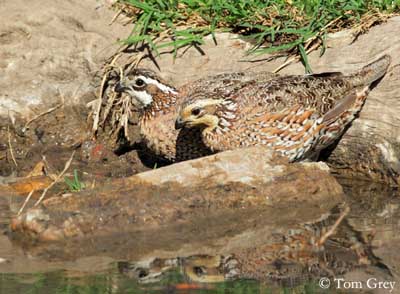
After the breeding season, the covey includes the family group and other isolated birds join them until the next spring.
The Northern Bobwhite is sedentary in its range, only performing some dispersion after the breeding season.
FLIGHT:
The Northern Bobwhite, as other Galliforme species, prefers to hide in the vegetation if alarmed, rather than to take off. However, if it does move off, it flushes and the take off can be explosive if there are several birds flying in all directions. But it can fly quite strongly with rapid wing-beats, but only over short distances, alternating series of rapid stiff wing-beats with short glides.

REPRODUCTION:
The breeding season varies in the USA, with peak in April/June.
The Northern Bobwhite nests on the ground in a shallow depression lined with grass and dead vegetation. The nest is often covered and hidden by a woven arch made with the standing vegetation around the nest, and we can see a small side entrance.
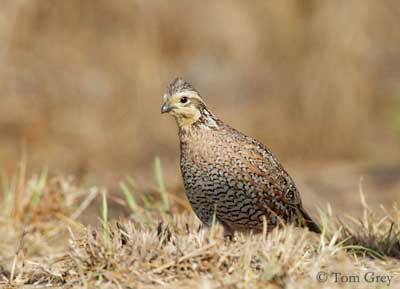
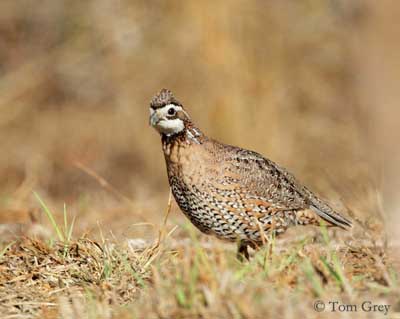
The female usually lays 12-14 eggs. If a second clutch is laid, there are fewer eggs. The incubation lasts about 23-26 days. The chicks are precocial and wander off from the nest soon after hatching. The female or both parents guard them. The chicks grow rapidly and can flutter at one week, and fly at two weeks of age.
One or more females often lay in another female’s nest. The eggs are dull white but they also can be stained by the soil or the vegetation in the nest.
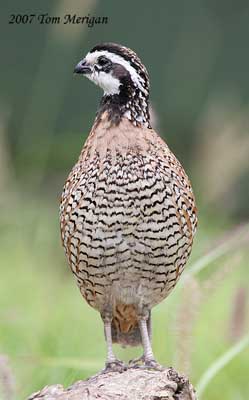
DIET:
The Northern Bobwhite feeds mainly on plant matter such as seeds of various plant species, acorns, leaves, buds, fruits and tubers. During the summer, it catches insects and spiders, and also takes snails and small vertebrates. They often forage in groups.
PROTECTION / THREATS / STATUS:
The Northern Bobwhite is threatened by changes in agricultural practices, overgrazing and use of herbicides which destroy their food resources, and habitat fragmentation. Declines are also due to hunting pressure every year in the USA.
The species is considered as Near Threatened, due to the rapid declines occurred in recent decades.